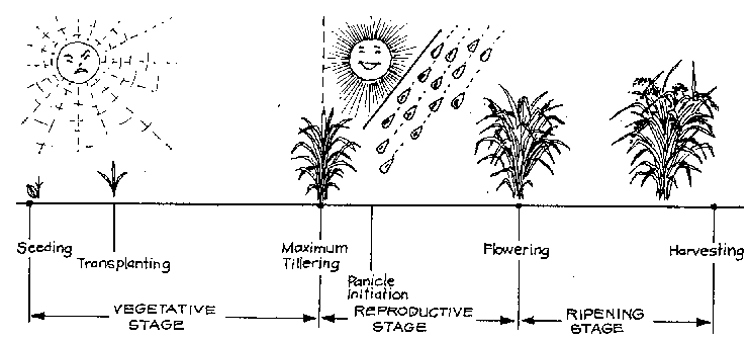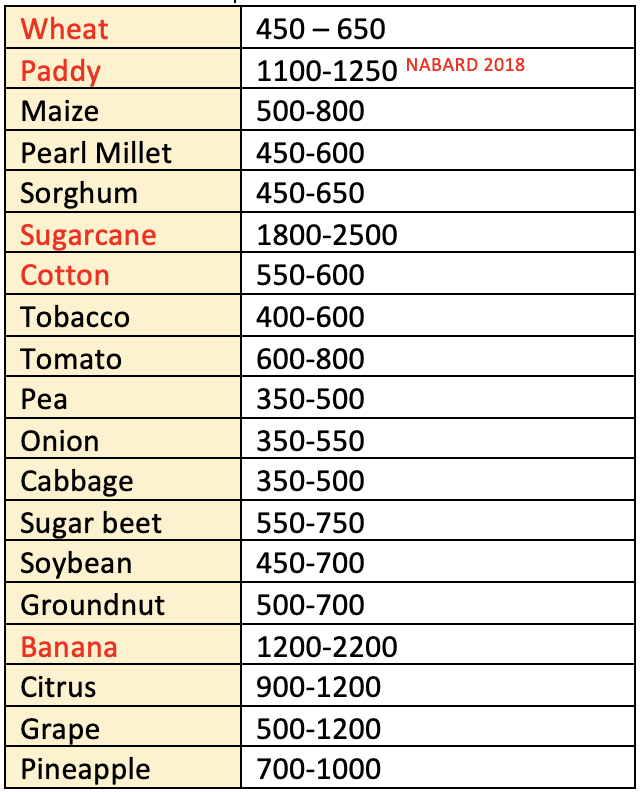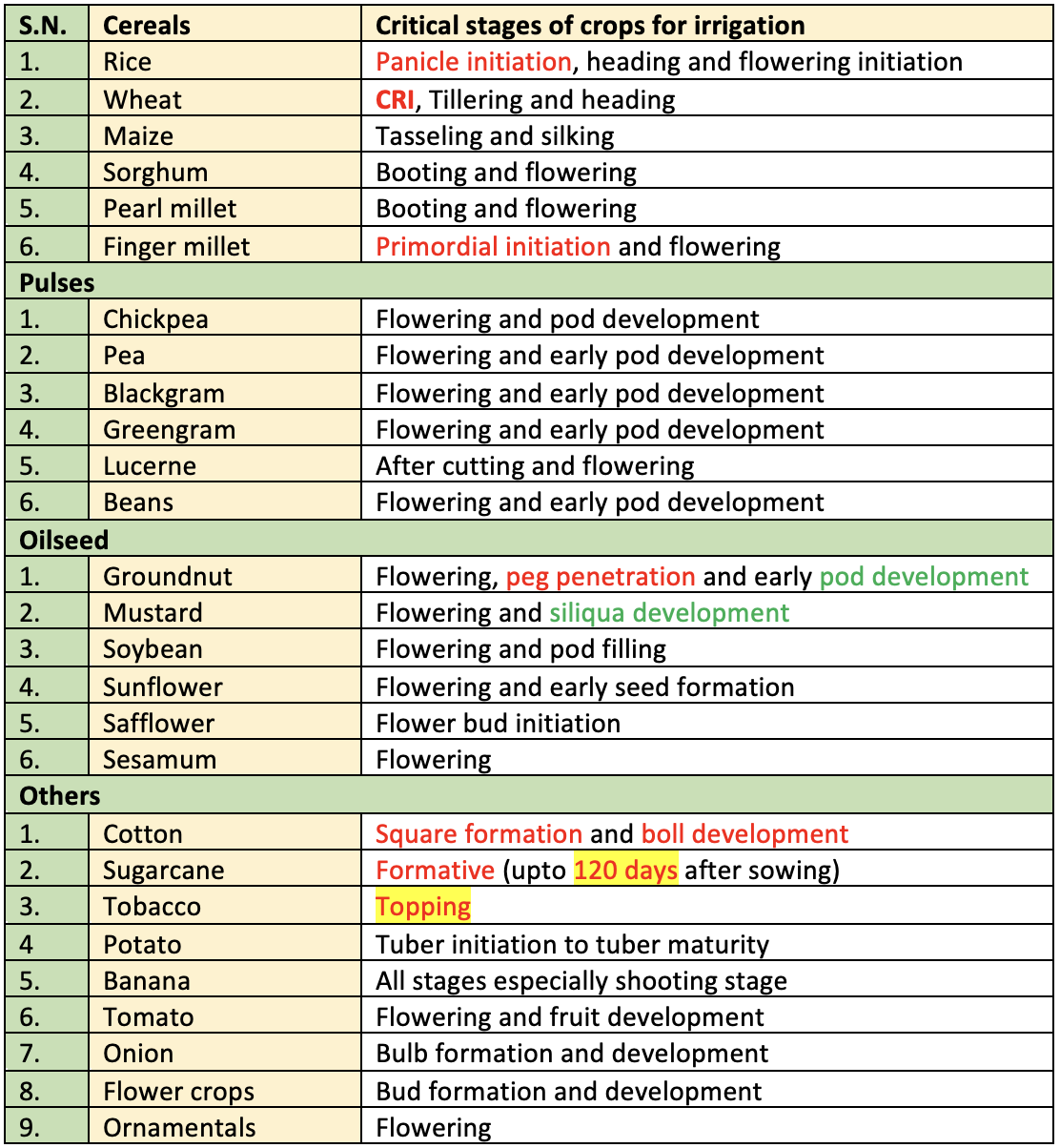🚿 Water Requirement
Learn about Water Requirement of different Crops, Critical Stage, Irrigation related terminologies.
Crop Water Requirement
- In order to choose the right irrigation technique, we have to be aware of various important parameters.
- One such parameter is the Crop-Water Requirement.
- Water requirements of a crop is the quantity of water needed for normal crop growth and yield in a period of time to a place and may be supplied by precipitation or by irrigation or by both.
- Water is needed mainly to meet the demand of evaporation (E), transpiration (T) and metabolic activity of plant together known as
Consumptive Use (C.U). - So,
Water requirement = IW + ER + S- IW - Irrigation Water, in cm
- ER – Effective Rainfall, in cm
- S – Soil profile contribution
Water Requirement of different crops
Rice
- The daily consumptive use of rice varies from 6-10 mm and total water is ranges from
1100 to 1250 mmdepending upon the agro climatic situation. - Of the total water required for the crop, 3% or 40 mm is used for the nursery, 16% or 200 mm for the land preparation i.e. puddling and 81% or 1000 mm for field irrigation of the crop.
- The growth of rice plant in relation to water management can be divided into four periods viz., Seedling, vegetative, reproductive and ripening.
- Less water is consumed during seedling stage. At the time of transplanting, shallow depth of 2 cm is adequate and maintained upto 7 days and there after 5 cm of submergence is necessary to facilitate development of new roots.
- The same water level is required for tiller production during the vegetative phase.
- At the beginning of the maximum tillering stage the entire water in the field can be drained and left as such for one or two days which is termed as
mid-season drainage. - This mid-season drainage may improve the respiratory functions of the roots, stimulate vigorous growth of roots and checks the development of non-effective tillers.
- Any stress during the vegetative phase may affect the root growth and reduce the leaf area and during flowering phase 5 cm submergenceNABARAD 2018 should be maintained because it is a critical stage of water requirement.
- Stress during this phase will impair all yield components and cause severe reduction in yield. Excess water than 5 cm is also not necessary especially at booting stage which may lead to delay in heading.
- Water requirement during ripening phase is less and water is not necessary after yellow ripening.
- Water can be gradually drained from the field 15-21 days ahead of harvest of crop.
- Whenever 5 cm submergence is recommended the irrigation management may be done by irrigating to 5 cm submergence at saturation or one or two days after the disappearance of ponded water.
- This will result in 30% saving of irrigation water compared to the continuous submergence.

Ground Nut
- Total water requirement:
500-550 mm. - Evapotranspiration is low during the first 35 days after sowing and last 35 days before harvest and reaches a peak requirement between peg penetration and pod development stages.
- After the sowing irrigation the second irrigation can be scheduled 25 days after sowing i.e. 4 or 6 days after first hand hoeing and thereafter irrigation interval of 15 days is maintained upto peak flowering.
- During the critical stages the interval may be 7 or 10 days depending upon the soil and climate. During maturity period the interval is 15 days.
Finger Millet / Ragi
- Total water requirement:
350 mm - Finger millet is a drought tolerant crop. Pre-planting irrigation at 7 or 8 cm is given.
- Third day after transplantation lifesaving irrigation with small quantity of water is sufficient for uniform establishment.
- Water is then withheld for 10-15 days after the establishment of seedling for healthy and vigorous growth.
- Subsequently three irrigations are essential at primordial initiation, flowering and grain filling stages.
Sorghum
- Total water requirement:
350-500 mm
Sugarcane
- Total water requirement:
1800-2200 mm Formative phase(120 daysfrom planting) is the critical period for water demand.- To ensure uniform emergence and optimum number of tillers per unit area
lesser quantity of water at more frequenciesis preferable. - The response for applied water is more during this critical phase during which the crop needs higher quantity of water comparing, the other two phases.
- Water requirement, number of irrigations etc., are higher during this period.
- As there is no secondary thickening of stem, elongation of stem as sink for storage of sugar it is desirable to maintain optimum level of moisture during grand growth period.
- Response for water is less in this stage and this will be still less in the ripening stage.
- During the ripening phase as harvesting time approaches soil moisture content should be allowed to decrease gradually so that growth of cane is checked and sucrose content is increased.
Maize
- Total water requirement:
500 – 600 mm - The water requirement of maize is higher, but it is very efficient in water use.
- Growth stages of maize crop are sowing, four leaf stage, knee high, grand growth, tasseling, silking, early dough and late dough stages.
- Crop uniformly requires water in all these stages. Of this,
tasseling,silkingandearly dough stagesare critical periods.
Cotton
- Total water requirement:
550 – 600 mm - Cotton is sensitive to soil moisture conditions.
- Little water is used by plant with early part of the season and more water is lost through evaporation than transpiration.
- As the plant grows, the use of water increases from 3 mm / day reaching a peak of 10 mm a day when the plant is loaded with flowers and boll.
- Water used during the emergence and early plant growth is only 10% of the total requirement. Ample moisture during
floweringandboll development stagesis essential. - In the early stage as well as at the end the crop requires less water.
- Water requirement remains high till the boll development stage.
- If excess water is given in the stages other than critical stages, it encourages the vegetative growth because it is an indeterminate plant thereby boll setting may be decreased. Irrigation is continued until the first boll of the last flush opens, and then irrigation is stopped.
Pulses
- Total water requirement:
200-450 mm - Mostly the pulses are grown under rainfed condition.
- Some pulse crops like Redgram, Blackgram, Greengram are grown in summer season as irrigated crop which need 3 to 4 irrigation at critical stags like
germination,floweringandpod formation.
Water Requirement of Different Crops

Critical stages of crops for irrigation
👉🏻 The period when water requirement is maximum is known as peak period of water requirement/critical stages.

Irrigation Terminologies
Water Use Efficiency (WUE)
- It is the yield of a marketable crop produced per unit of water used in evapo-transpiration or it is the dry matter produced per unit of water used and it is expressed as
kg/ha-mm (cm). - The water use efficiency (WUE) in Indian agriculture at about
30-40%is one of the lowest in the world, against 55% in China. - Water Use Efficiency is of two types:
Field Water Use Efficiency
- It is the ratio of crop yield to the total amount of water used in the field.

- Where,
- ET - Evapotranspiration loss of water
- S - Ground water contribution
- D - Deep Percolation losses
Crop Water Use Efficiency
- It is the ratio of crop yield to the amount of water depleted by the crop in the process of evapotranspiration.

- Where,
- E - Evaporation loss
- T - Transpiration loss
- G - Metabolic use of plant
Water use efficiency of major field crops

Consumptive Water Use Efficiency
It is defined as the ratio of consumptive water use by the crop of irrigated farm or project and the irrigation water stored in the root zone of the soil on the farm or the project area.

- Ecu = Consumptive use efficiency, per cent
- Wcu = Normal Consumptive use of water
- Wd = Net amount of water depleted from root zone soil
What is Consumptive Use of Water?
- It is used to designate the losses due to
evapotranspirationand the water used by the plant for itsmetabolic activities. CU = ET + water used in metabolic activities- Since water used in the actual metabolic process is less than 1% of Evapotranspiration, it is insignificant and thus the term Consumptive Use = Evapotranspiration.
Irrigation Requirement
I.R. = (W.R.) – (E.R. + G.W.)- Where,
- W.R. = Water requirement
- E.R. = Effective rainfall
- GW = Ground water
Irrigation Efficiency
It is defined as the ratio of water output to the water input, i.e., the ratio or percentage of the irrigation water consumed by the crop of an irrigated farm, field or project to the water delivered from the source.

- Where,
- Ei = irrigation efficiency (%)
- Wc = irrigation water consumed by crop during its growth period in an irrigation project
- Wr = water delivered from canals during the growth period of crops
In most irrigation projects, the irrigation efficiency ranges between 12 to 34 %.
Water Storage Efficiency
It is defined as the ratio of the water stored in the root depth by irrigation to the water needed in the root depth to bring it to the field capacity. Also termed as water storage factor.

- Where,
- Es = water storage efficiency, per cent
- Ws = water stored in the root zone during the irrigation
- Ww = water needed in the root zone prior to irrigation, i.e., field capacity available.
Water Conveyance Efficiency
- It is a measure of efficiency of water conveyance system from canal network to watercourses and field channels.
- It is the ratio of water delivered infields at the outlet head to that diverted into the canal system from the river or reservoir. Water losses occur in conveyance from the point of diversion till it reaches the farmer’s fields which can be evaluated by water conveyance efficiency, as under:

- Where,
- Ec = water conveyance efficiency, per cent
- Wf= water delivered to the farm by conveyance system (at field supply channel)
- Wt = water introduced into the conveyance system from the point of diversion
- Water conveyance efficiency is generally low, about 21% losses occur in earthen watercourses only.
Other Terminologies related to Irrigation
Gross Command Area (GCA)
- This Gross Command Area (GCA) includes
cultivable landas well asbarren land,forests,houses,wasteland,roadsetc. NABARD 2021
Culturable Command Area (CCA)
- Cultivable Command Area is that part of Gross Command Area, which is fit for cultivating crops. So, cultivable area excludes forest and barren land from the Gross Command Area.
- The area which can be irrigated from a scheme and is fit for cultivation.
Gross Irrigated Area
- The area irrigated under various crops during a year, counting the area irrigated under
more than onecrop during the same year as many times as the number of crops grown and irrigated.
Irrigation Potential Created
- The total gross area
proposed to be irrigatedunder different crops during a year by a scheme. The area proposed to be irrigated under more than one crop during the same year is counted as many times as the number of crops grown and irrigated.
Irrigation Potential Utilized
- The gross area
actually irrigatedduring reference year out of the gross proposed area to be irrigated by the scheme during the year.
Fertigation
- It is the application of fertilizers through the irrigation system.
- Commonly used fertilizers are
Ammonium Nitrate (34-0-0)- Ammonium Sulphate (21-0-0)
- Urea (46-0-0)
- Diammonium Phosphate (18-46-0)
- Potassium Chloride (0-0-60)
Potassium Nitrate (13-0-44)etc.
Crop Water Requirement
- In order to choose the right irrigation technique, we have to be aware of various important parameters.
- One such parameter is the Crop-Water Requirement.
- Water requirements of a crop is the quantity of water needed for normal crop growth and yield in a period of time to a place and may be supplied by precipitation or by irrigation or by both.
- Water is needed mainly to meet the demand of evaporation (E), transpiration (T) and metabolic activity of plant together known as
Consumptive Use (C.U). - So,
Water requirement = IW + ER + S- IW - Irrigation Water, in cm
- ER – Effective Rainfall, in cm
- S – Soil profile contribution
Water Requirement of different crops
Rice
- The daily consumptive use of rice varies from 6-10 mm and total water is ranges from
1100 to 1250 mm …
Become Successful With AgriDots
Learn the essential skills for getting a seat in the Exam with
🦄 You are a pro member!
Only use this page if purchasing a gift or enterprise account
Plan
- Unlimited access to PRO courses
- Quizzes with hand-picked meme prizes
- Invite to private Discord chat
- Free Sticker emailed
Lifetime
- All PRO-tier benefits
- Single payment, lifetime access
- 4,200 bonus xp points
- Next Level
T-shirt shipped worldwide

Yo! You just found a 20% discount using 👉 EASTEREGG

High-quality fitted cotton shirt produced by Next Level Apparel